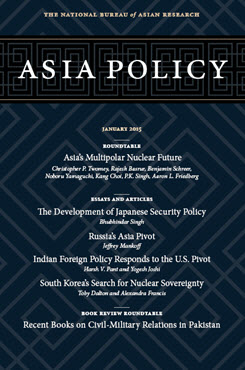Russia's Asia Pivot
Confrontation or Cooperation?
This article examines the origins and conduct of Russia’s Asia pivot, analyzes the role Asia plays in Russia’s economic development plans, and assesses Russia’s efforts to balance its strategic partnership with China and its ambitions to be a more autonomous player in Asia.
EXECUTIVE SUMMARY
MAIN ARGUMENT
Recent tensions between Russia and the West highlight Russia’s growing ties with Asia, particularly China. Before the Ukraine crisis, this pivot to Asia had more to do with Moscow’s assessment that Asia will be the major source of future economic growth. Russia seeks Asian, especially Chinese, investment to open up new sources of oil and gas, which will in turn allow it to play a larger role in regional security and diplomacy. Economic ties are the basis for the deepening Sino-Russian partnership, while Beijing has also provided important diplomatic support as the West has sought Russia’s isolation. Yet to avoid excessive dependence on China, Russia has worked to cultivate relations with other Asian powers, especially India, Vietnam, and Japan. This interest in harnessing Asian economic growth gives Moscow and Washington a common interest in regional stability, but one that is unlikely to be fully realized as long as bilateral relations remain focused on Europe and Eurasia.
POLICY IMPLICATIONS
- While Russia has been pursuing a more revisionist approach in Europe and Eurasia, in the Asia-Pacific it remains largely a status quo power, whose interests in continued economic growth and stability mostly parallel those of the U.S.
- While China is Russia’s most important partner in Asia, the growing disparity between Russian and Chinese power has encouraged Moscow to hedge. Western efforts to isolate Russia risk undermining this balancing act and pushing Russia closer to China.
- Russia’s efforts to play a larger role in Asia create opportunities for the U.S. to seek deeper engagement on issues of mutual interest, including North Korea, nuclear security, economic development, and trade.
About Asia Policy
Asia Policy is a peer-reviewed scholarly journal presenting policy-relevant academic research on the Asia-Pacific that draws clear and concise conclusions useful to today’s policymakers. Asia Policy is published quarterly in January, April, July, and October and accepts submissions on a rolling basis. Learn more


